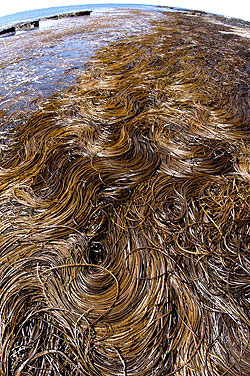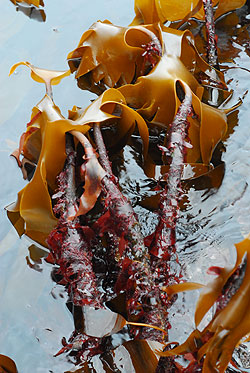Irish seaweed biomass
 Most of the seaweed biomass in the North Atlantic is provided by a relatively small number of species: the kelps (Laminaria and its relatives),
wracks (Fucus and its relatives), and the detached coralline algae
known as maërl. Wracks are mainly found in the intertidal, whereas
kelps are confined largely to the subtidal. In general, kelps on the east
coast (Counties Louth, Dublin, Wicklow and north County Wexford) occur to depths
of a maximum of 8 m, whereas in the optically clearer waters of the north-western,
western and south-western coasts, they may occur to 25 m and, exceptionally,
to 32 m. Maërl is composed of red algae that secrete lime; they are
mainly found from 0-25 m, but occasionally occur to depths of up to 70 m.
Most of the seaweed biomass in the North Atlantic is provided by a relatively small number of species: the kelps (Laminaria and its relatives),
wracks (Fucus and its relatives), and the detached coralline algae
known as maërl. Wracks are mainly found in the intertidal, whereas
kelps are confined largely to the subtidal. In general, kelps on the east
coast (Counties Louth, Dublin, Wicklow and north County Wexford) occur to depths
of a maximum of 8 m, whereas in the optically clearer waters of the north-western,
western and south-western coasts, they may occur to 25 m and, exceptionally,
to 32 m. Maërl is composed of red algae that secrete lime; they are
mainly found from 0-25 m, but occasionally occur to depths of up to 70 m.
The main biomass of wracks is provided in the intertidal by species of Fucus (four common and one rare), Pelvetia (one common species) and Ascophyllum (one common species). While the first two genera have been grazed by or fed to animals for centuries, Ascophyllum nodosum, a North Atlantic endemic, is economically the most important wrack in the area. In Ireland, although it occurs right around the coast, the main resources of Ascophyllum are found in the south-west, mid-west and north-west.
 Kelp biomass is provided mostly in the subtidal by two species of Laminaria and one each of Saccharina and Sacchorhiza. The most important kelp is Laminaria hyperborea (left),
the cast stipes of which are currently collected, dried and exported for
alginate production. The other two species are not at present collected
for alginate production in Ireland, but are gathered in very small quantities
as food. All three kelps occur right around the coast, in many places achieving
enormous biomasses. Laminaria digitata is the kelp that one commonly
sees at low water, whereas L. hyperborea occurs in deeper water. Saccharina latifolia occurs sporadically amongst L. digitata but often becomes the dominant species on wave-sheltered shores. Saccorhiza
polyschides is an annual, shallow-water species of irregular occurrence
and distribution. While it grows very rapidly, it is of little economic
interest because of difficulties of harvesting and usage.
Kelp biomass is provided mostly in the subtidal by two species of Laminaria and one each of Saccharina and Sacchorhiza. The most important kelp is Laminaria hyperborea (left),
the cast stipes of which are currently collected, dried and exported for
alginate production. The other two species are not at present collected
for alginate production in Ireland, but are gathered in very small quantities
as food. All three kelps occur right around the coast, in many places achieving
enormous biomasses. Laminaria digitata is the kelp that one commonly
sees at low water, whereas L. hyperborea occurs in deeper water. Saccharina latifolia occurs sporadically amongst L. digitata but often becomes the dominant species on wave-sheltered shores. Saccorhiza
polyschides is an annual, shallow-water species of irregular occurrence
and distribution. While it grows very rapidly, it is of little economic
interest because of difficulties of harvesting and usage.
The biomass of most of the red algae is considerably less than that of brown algae and very few of the 274 species that occur in Ireland (more information) are used. Perhaps the most spectacular of the reds are the corallines that make up maërl deposits estimated to be in excess of 8 million t, mainly in the inner and outer reaches of Galway Bay.
Other red algae of economic value include Palmaria palmata or dulse and Chondrus crispus and Mastocarpus stellatus , collectively known as Carrageen or Irish moss. No survey of dulse has been carried out in this country, although casual observations indicate that it is commoner on the south and north coasts than in the west or east. The harvestable resources of carrageen moss in Ireland are, at most, about 600 t.





